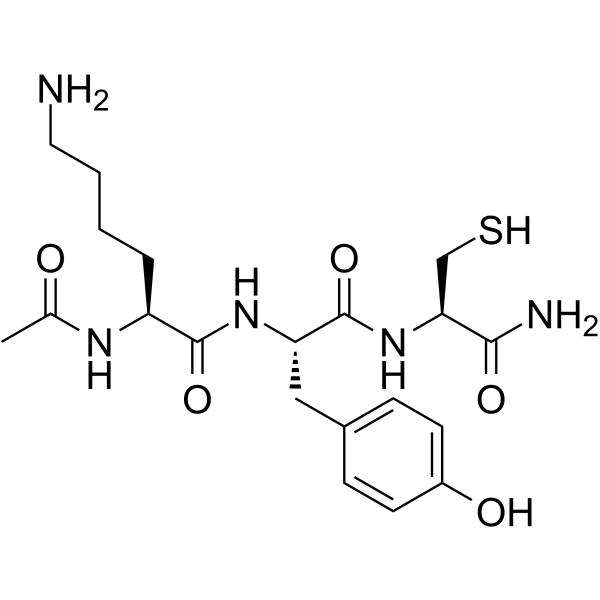| Cas No.: | 1287585-40-3 |
| Chemical Name: | N-acetyl lysyltyrosylcysteine amide |
| Synonyms: | Myeloperoxidase inhibitor KYC |
| SMILES: | SC[C@@H](C(N)=O)NC([C@H](CC1=CC=C(O)C=C1)NC([C@H](CCCCN)NC(C)=O)=O)=O |
| Formula: | C20H31N5O5S |
| M.Wt: | 453.56 |
| Purity: | >98% |
| Sotrage: | 2 years -20°C Powder, 2 weeks 4°C in DMSO, 6 months -80°C in DMSO |
| Publication: | [1]. Yu G, et al. Inhibition of myeloperoxidase oxidant production by N-acetyl lysyltyrosylcysteine amide reduces brain damage in a murine model of stroke [published correction appears in J Neuroinflammation. 2016;13(1):166]. J Neuroinflammation. 2016;13(1):119. Published 2016 May 24. [2]. Zhang H, et al. N-acetyl lysyltyrosylcysteine amide inhibits myeloperoxidase, a novel tripeptide inhibitor. J Lipid Res. 2013;54(11):3016-3029. |
| Description: | N-acetyl lysyltyrosylcysteine amide (KYC) is a potent, tripeptide inhibitor of myeloperoxidase (MPO), inhibits MPO-mediated hypochlorous acid (HOCl) formation (IC50=7 uM) and nitration/oxidation of LDL; completely inhibits HOCl production at 25 uM, decreases vascular oxidative stress and increases vasodilatation in sickle cell disease mice; reduces oxidative stress-mediated inflammation, neuronal damage, and neural stem cell injury in murine model of stroke. |
| In Vivo: | N-Acetyl lysyltyrosylcysteine amide (KYC) significantly decreases infarct size, blood-brain barrier leakage, infiltration of myeloid cells, loss of neurons, and apoptosis in the brains of middle cerebral artery occlusion (MCAO) mice. N-Acetyl lysyltyrosylcysteine amide (10 mg/kg; i.p.; daily for 3-7 days) significantly reduces neurological severity scores and infarct size in MCAO mice. N-Acetyl lysyltyrosylcysteine amide (10 mg/kg; i.p.; daily 7 days) significantly protects BBB function and decreased neutrophil infiltration. N-Acetyl lysyltyrosylcysteine amide (10 mg/kg; i.p.; daily 7 days) significantly reduces microglia/macrophage activation and neuron loss in MCAO mice. N-Acetyl lysyltyrosylcysteine amide (10 mg/kg; i.p.; daily for 3-7 days) decreases apoptosis and cell injury in the brains of MCAO mice. N-Acetyl lysyltyrosylcysteine amide reduced MPO in the brains of MCAO mice. N-Acetyl lysyltyrosylcysteine amide reduces NO2Tyr and 4-HNE in MCAO mice. |
| References: | [1]. Yu G, et al. Inhibition of myeloperoxidase oxidant production by N-acetyl lysyltyrosylcysteine amide reduces brain damage in a murine model of stroke [published correction appears in J Neuroinflammation. 2016;13(1):166]. J Neuroinflammation. 2016;13(1):11 [2]. Zhang H, et al. N-acetyl lysyltyrosylcysteine amide inhibits myeloperoxidase, a novel tripeptide inhibitor. J Lipid Res. 2013;54(11):3016-3029. |






















